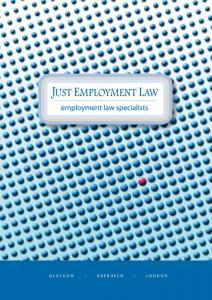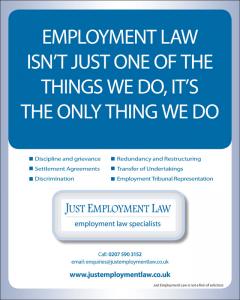The so-called ‘gig economy,’ where individuals are engaged by businesses on an ad hoc basis, has brought the issue of employment status back into the spotlight and readers may be aware of the recent decision to hit the headlines regarding Pimlico Plumbers.
Questions about employment status often arise in relation to those working on a freelance basis within the plumbing industry. In this article, Louise Walker, Senior Solicitor at Just Employment Law, explains the different types of employment status and the importance for businesses of getting this right
Categories of working arrangements
In relation to employment status, the law recognises three categories: employees, workers and the self-employed. Of these categories, employees have the greatest  employment rights, while workers have fewer statutory rights, but are entitled to some important protections. Genuinely self-employed people have little or no statutory employment protection.
employment rights, while workers have fewer statutory rights, but are entitled to some important protections. Genuinely self-employed people have little or no statutory employment protection.
Many businesses mistakenly assume that employment status is determined by someone’s tax arrangements. It is important to understand that HMRC and employment tribunals can come to different views on whether the same person’s working arrangements amount to employment status. In principle, it is possible for someone to be on PAYE for tax purposes but not to have employment rights, and vice-versa.
Rights applying to these categories
Only employees have the right to claim unfair dismissal, normally subject to a minimum service qualification period of two years. They are also entitled to various statutory payments including redundancy pay, sick pay, maternity pay and paternity pay.
Employees are entitled to minimum notice periods and can apply for flexible working. They also benefit from the protection of the TUPE Regulations to protect their employment where it is transferred to a different employer.
Workers have the right not to have unlawful deductions made from wages. They are also entitled to be paid the National Minimum Wage. Under working time laws, they also benefit from paid holidays and minimum rest periods.
While anti-discrimination laws state that you have to be an employee to bring a claim for discrimination at the employment tribunal, there is a different and wider definition of ‘employee’ under these laws, so that all but the genuinely self-employed have this right. The self-employed might still in some circumstances be able to bring discrimination claims in the civil courts.
 Employee Status
Employee Status
As far as employment rights are concerned, case law tells us that the following are the most important factors in deciding whether someone is an employee:
1. Mutuality of obligation – an obligation on the organisation to provide work, and an obligation on the individual to accept that work when it is offered. Where there is mutuality of obligation, this is a strong indication of employee status.
2. Personal service – is the individual required to do the work personally? An employee would normally be required to provide work personally, whereas the self-employed can often provide a substitute or subcontract the work.
3. Control – the level of control that the organisation has over the individual such as control over what is to be done, how it is to be done, where and when it is to be done. This is often evidenced by having set hours of work, a line manager and being subject to the employer’s rules and procedures.
If any of these three factors are missing from the relationship, it is unlikely to be employment. It is possible, but unusual, for all these factors to be present and for there still to be no employment relationship, if there are other factors in the relationship which would be inconsistent with employment.
We can see therefore that many of the working arrangements in the gig economy will not amount to employment. However, very often, these types of arrangement will bring with them ‘worker’ rights, as we saw in the recent high-profile case involving Uber taxi drivers. Because ‘worker’ is an easier test to satisfy, anyone who is an employee will automatically be a ‘worker’ too.
To be a ‘worker’, there are only two simple criteria you have to meet. Firstly, you must be obliged to do the work personally. Secondly, you must not be providing a professional service or operating a business undertaking, where the person or organisation you do the work for is a customer or client of yours.
There is no legal definition of self-employment, but if you are neither an employee nor a worker, by default you are probably self-employed.
Not with standing these definitions, it can often be difficult to determine an individual’s employment status and, if a business gets this wrong, there can be costly implications.
Importance of getting it right
Clearly, if an individual is wrongly categorised in terms of their employment status and they do not receive the employment rights to which they are entitled, this could expose an organisation to a tribunal claim. It can also lead to penalties being imposed if, for example, the minimum wage is not paid where it should be.
Having clear contractual documentation in place can therefore greatly benefit an organisation and provide a degree of protection if an individual challenges their employment status.
With the increasing number of well-publicised tribunal cases in this area, organisations should take specialist legal advice on their current arrangements.
Just Employment Law specialises exclusively in the field of employment law providing bespoke advice and assistance to clients throughout the UK. If you have any queries in relation to this article or would like to get in touch, please call 0141 331 5150 or email enquiries@justemploymentlaw.co.uk.



Add new comment